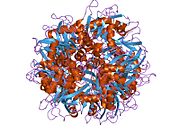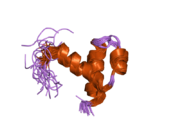CSTF2T
Protein-coding gene in the species Homo sapiens
| CSTF2T | |||||||||||||||||||||||||||||||||||||||||||||||||||
|---|---|---|---|---|---|---|---|---|---|---|---|---|---|---|---|---|---|---|---|---|---|---|---|---|---|---|---|---|---|---|---|---|---|---|---|---|---|---|---|---|---|---|---|---|---|---|---|---|---|---|---|
 | |||||||||||||||||||||||||||||||||||||||||||||||||||
| Identifiers | |||||||||||||||||||||||||||||||||||||||||||||||||||
| Aliases | CSTF2T, CstF-64T, cleavage stimulation factor subunit 2, tau variant, cleavage stimulation factor subunit 2 tau variant | ||||||||||||||||||||||||||||||||||||||||||||||||||
| External IDs | OMIM: 611968; MGI: 1932622; HomoloGene: 80230; GeneCards: CSTF2T; OMA:CSTF2T - orthologs | ||||||||||||||||||||||||||||||||||||||||||||||||||
| |||||||||||||||||||||||||||||||||||||||||||||||||||
| |||||||||||||||||||||||||||||||||||||||||||||||||||
| |||||||||||||||||||||||||||||||||||||||||||||||||||
| |||||||||||||||||||||||||||||||||||||||||||||||||||
| |||||||||||||||||||||||||||||||||||||||||||||||||||
| Wikidata | |||||||||||||||||||||||||||||||||||||||||||||||||||
| |||||||||||||||||||||||||||||||||||||||||||||||||||
Cleavage stimulation factor 64 kDa subunit, tau variant is a protein that in humans is encoded by the CSTF2T gene.[5][6][7]
References
- ^ a b c GRCh38: Ensembl release 89: ENSG00000177613 – Ensembl, May 2017
- ^ a b c GRCm38: Ensembl release 89: ENSMUSG00000053536 – Ensembl, May 2017
- ^ "Human PubMed Reference:". National Center for Biotechnology Information, U.S. National Library of Medicine.
- ^ "Mouse PubMed Reference:". National Center for Biotechnology Information, U.S. National Library of Medicine.
- ^ Dass B, McDaniel L, Schultz RA, Attaya E, MacDonald CC (Oct 2002). "The gene CSTF2T, encoding the human variant CstF-64 polyadenylation protein tauCstF-64, lacks introns and may be associated with male sterility". Genomics. 80 (5): 509–14. doi:10.1016/S0888-7543(02)96862-X. PMID 12408968.
- ^ Dass B, McMahon KW, Jenkins NA, Gilbert DJ, Copeland NG, MacDonald CC (May 2001). "The gene for a variant form of the polyadenylation protein CstF-64 is on chromosome 19 and is expressed in pachytene spermatocytes in mice". J Biol Chem. 276 (11): 8044–50. doi:10.1074/jbc.M009091200. PMID 11113135.
- ^ "Entrez Gene: CSTF2T cleavage stimulation factor, 3' pre-RNA, subunit 2, 64kDa, tau variant".
External links
- Human CSTF2T genome location and CSTF2T gene details page in the UCSC Genome Browser.
Further reading
- Maruyama K, Sugano S (1994). "Oligo-capping: a simple method to replace the cap structure of eukaryotic mRNAs with oligoribonucleotides". Gene. 138 (1–2): 171–4. doi:10.1016/0378-1119(94)90802-8. PMID 8125298.
- Bonaldo MF, Lennon G, Soares MB (1997). "Normalization and subtraction: two approaches to facilitate gene discovery". Genome Res. 6 (9): 791–806. doi:10.1101/gr.6.9.791. PMID 8889548.
- Suzuki Y, Yoshitomo-Nakagawa K, Maruyama K, et al. (1997). "Construction and characterization of a full length-enriched and a 5'-end-enriched cDNA library". Gene. 200 (1–2): 149–56. doi:10.1016/S0378-1119(97)00411-3. PMID 9373149.
- Ishikawa K, Nagase T, Suyama M, et al. (1998). "Prediction of the coding sequences of unidentified human genes. X. The complete sequences of 100 new cDNA clones from brain which can code for large proteins in vitro". DNA Res. 5 (3): 169–76. doi:10.1093/dnares/5.3.169. PMID 9734811.
- Wiemann S, Weil B, Wellenreuther R, et al. (2001). "Toward a Catalog of Human Genes and Proteins: Sequencing and Analysis of 500 Novel Complete Protein Coding Human cDNAs". Genome Res. 11 (3): 422–35. doi:10.1101/gr.GR1547R. PMC 311072. PMID 11230166.
- Simpson JC, Wellenreuther R, Poustka A, et al. (2001). "Systematic subcellular localization of novel proteins identified by large-scale cDNA sequencing". EMBO Rep. 1 (3): 287–92. doi:10.1093/embo-reports/kvd058. PMC 1083732. PMID 11256614.
- Strausberg RL, Feingold EA, Grouse LH, et al. (2003). "Generation and initial analysis of more than 15,000 full-length human and mouse cDNA sequences". Proc. Natl. Acad. Sci. U.S.A. 99 (26): 16899–903. Bibcode:2002PNAS...9916899M. doi:10.1073/pnas.242603899. PMC 139241. PMID 12477932.
- Pérez Cañadillas JM, Varani G (2003). "Recognition of GU-rich polyadenylation regulatory elements by human CstF-64 protein". EMBO J. 22 (11): 2821–30. doi:10.1093/emboj/cdg259. PMC 156756. PMID 12773396.
- Beausoleil SA, Jedrychowski M, Schwartz D, et al. (2004). "Large-scale characterization of HeLa cell nuclear phosphoproteins". Proc. Natl. Acad. Sci. U.S.A. 101 (33): 12130–5. Bibcode:2004PNAS..10112130B. doi:10.1073/pnas.0404720101. PMC 514446. PMID 15302935.
- Gerhard DS, Wagner L, Feingold EA, et al. (2004). "The Status, Quality, and Expansion of the NIH Full-Length cDNA Project: The Mammalian Gene Collection (MGC)". Genome Res. 14 (10B): 2121–7. doi:10.1101/gr.2596504. PMC 528928. PMID 15489334.
- Zhao X, Oberg D, Rush M, et al. (2005). "A 57-Nucleotide Upstream Early Polyadenylation Element in Human Papillomavirus Type 16 Interacts with hFip1, CstF-64, hnRNP C1/C2, and Polypyrimidine Tract Binding Protein". J. Virol. 79 (7): 4270–88. doi:10.1128/JVI.79.7.4270-4288.2005. PMC 1061554. PMID 15767428.
- Rual JF, Venkatesan K, Hao T, et al. (2005). "Towards a proteome-scale map of the human protein-protein interaction network". Nature. 437 (7062): 1173–8. Bibcode:2005Natur.437.1173R. doi:10.1038/nature04209. PMID 16189514. S2CID 4427026.
- Lim J, Hao T, Shaw C, et al. (2006). "A protein-protein interaction network for human inherited ataxias and disorders of Purkinje cell degeneration". Cell. 125 (4): 801–14. doi:10.1016/j.cell.2006.03.032. PMID 16713569. S2CID 13709685.
- v
- t
- e
PDB gallery
-
 1p1t: NMR Structure of the N-terminal RRM domain of Cleavage stimulation factor 64 KDa subunit
1p1t: NMR Structure of the N-terminal RRM domain of Cleavage stimulation factor 64 KDa subunit -
 2j8p: NMR STRUCTURE OF C-TERMINAL DOMAIN OF HUMAN CSTF-64
2j8p: NMR STRUCTURE OF C-TERMINAL DOMAIN OF HUMAN CSTF-64
 | This article on a gene on human chromosome 10 is a stub. You can help Wikipedia by expanding it. |
- v
- t
- e





















